| ATLAS F1 Volume 6, Issue 24 | |||
 |
Atlas F1 Exclusive Max Mosley: Face to Face | ||
| by Thomas O'Keefe, U.S.A. | |||
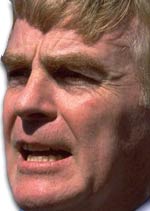 In the final part of Thomas O'Keefe's four-part series on Max Mosley and the European Commission proceedings against F1's governing body, the President of the FIA addresses the issues that are most compelling to the general fans: why he won't bring back slicks, why he doesn't name the cheating team of 1999, why Bernie can't sell the TV rights to others and why he loves his job so much In the final part of Thomas O'Keefe's four-part series on Max Mosley and the European Commission proceedings against F1's governing body, the President of the FIA addresses the issues that are most compelling to the general fans: why he won't bring back slicks, why he doesn't name the cheating team of 1999, why Bernie can't sell the TV rights to others and why he loves his job so much
One striking aspect of Mosley's views on the subjects of overtaking and the hated grooved tires is his educational background in the sciences and his complete and utter commitment to the safety of the drivers who strap themselves into those Formula One cars.
As a physics major, he actually seems to understand the mathematics that prove out the axioms that the severity of an impact will be proportional to the grip of the tires and that a car will spin for half the radius of the curve it is in when the spin begins; "you could draw it up on a half sheet of paper," he says.
"We are always told 'reduce the aerodynamics'. Trouble is we've learned from experience that it never succeeds. For thirty years we've been constantly trying to reduce the aerodynamic potential of the cars to keep the speeds in check and this has failed.
"So if you have a responsible governing body you must have a final point of defense and that for us is the grooved tires. Now if we had some magic way of reducing the downforce or, even better, reducing the downforce and increasing the ability of the cars to run close to each other in the corners we would take it but we know there isn't.
"In the end, if they are on bicycle tires - and obviously you don't want to go to that extreme - they could have 10,000 horsepower and all the downforce they want and they will not go quick enough in the corners to hurt themselves. So it is finding a balance that is our objective.
"But the grooved tires were probably the most important contribution to keeping speed and therefore safety under control."
In short, those in Formula One who are waiting for the return of slicks and turbos should not hold their breath. Says Mosley: "The idea of going back to slicks I think is highly unlikely in Formula One ... and turbos still less."
Max does not believe that the grooved tires were a mistake because they have achieved the safety objectives which led to their development, but he is open to discussions with the tire suppliers about developing a low profile tire with something he calls "an agreed standard tread pattern" to be used by Bridgestone, Michelin and any other future tire suppliers. "If I had my way we would have low profile tires with tread as we have on modern road cars, which would look better and look more modern," Mosley adds.
"If we get all the evidence we will act," he says, "and the team will be called before the FIA's World Council." He suspects that sanctions against the team found to have cheated will be severe, meaning not just a monetary fine. In any event, although the cheating "may have made some difference in [the cheating team's] position in the Championship it did not alter the Championship in any way that anyone would care about," says Mosley.
Although not willing to disclose that particular State Secret, Mosley he did disclose confidentially and exclusively to Atlas F1 on the weekend of the British Grand Prix what he declined to reveal to the world's motoring press at his press conference before the San Marino Grand Prix:
At that time, referring to the recent acquisition by EM.TV - the company that owns the Muppets TV show characters - of 50% of Bernie Ecclestone's shares in Formula One, Mosley told the press that he "believed that through the Muppet connection [the head of EM. TV, Thomas Haffa] has acquired an appropriate nickname from Mr. Ecclestone. Sadly, I don't think it is up to me to reveal to the press what that name is." After ruthless cross-examination by your Interlocutor, the ex-Barrister finally gave up the goods: Bernie has dubbed Haffa "Kermit".
As to Bernie giving it all up and going on Social Security, Mosley doubts it. He takes Bernie at his word and believes he will be coming to Grands Prix for some time to come, certainly until the public floatation of Formula One is completed or is definitively put off because of the European Commission proceeding, whichever comes first. Says Mosley: "Bernie is one of those people that has made a big contribution and continues to do so. And I think that as long as he wants to go on, everyone will want him to go on."
As for the increasingly topical subject of women coming into Formula One, Mosley turns out to be pro-women and believes it is just a matter of increasing the percentage of women coming up from the lower formulas. When asked if he agreed with an idea floated by Eddie Jordan over the weekend at Silverstone for a Women's Grand Prix class, Mosley responded that he believes women should be able to compete with men in the same class: "Formula One isn't rugby."
Mosley gave the example of Michelle Mouton, who enjoyed great success in the World Rally Cars, certainly not a formula for the weak and squeamish amongst us. As it happened, BMW's Gerhard Berger was in Mosley's suite when the discussion of a Women's Grand Prix class came up; Berger immediately volunteered "to be the Max Mosley of the Women's Grand Prix" if it should ever come to pass: someone has to do it.
As it happened, the 1992 Indy 500 that he attended was an eventful one from beginning to end. The 1992 Indy race took place on a chilly, overcast day that saw pole-sitter (and ex-Formula One driver) Roberto Guerrero spin off the track on the parade lap while trying to warm up his tires; the pattern of accidents continued throughout the race but in the end, Al Unser, Jr. just beat perennial Indy 500 bridesmaid Scott Goodyear by half a car length - 0.43 seconds - in the closest finish in the history of the Indy 500.
Ironically, Mosley lost his balance and injured himself in a fall while at the Speedway and found himself rushed to Methodist Hospital in Indianapolis where he found himself amidst the 10 or so drivers that had previously been sent there for treatment because of the rash of race incidents. Having inspected the hospital facilities during his last visit to Indy, Max hopes to stay long enough at the Inaugural United States Grand Prix this coming September to see the podium ceremony this time around.
Finally, come what may at the European Commission, Max confirms that he intends to stand for re-election as the President of FIA when his terms expires in October 2001.
|
||||
|
He gives the impression of a man thoroughly enjoying his work, the legal aspects, the political aspects, the technical issues, the personalities, the whole shebang. And what's not to like in a job where you get to preside over one of the world's most spectacular sports and deal on a day-to-day basis with potentates from 119 Member Countries of the FIA and friends and colleagues in racing that you have known literally for your entire adult life.
When once asked in a press conference what compensation the President of the FIA receives for presiding over all this, Mosley's response typified the genteel aplomb with which he carries the whole thing off: "You get great privileges and a very interesting life as President of the FIA, but the object is not to make money." Whether you believe him or not - the purpose of this article is to permit you to decide for yourself.
|
Face to Face with Max Mosley - Part I (May-24, 2000)
Face to Face with Max Mosley - Part II
Face to Face with Max Mosley - Part III
Mosley's Equations | |||
| Thomas O'Keefe | © 2000 Kaizar.Com, Incorporated. |
| Send comments to: okeefe@atlasf1.com | Terms & Conditions |
Credit for image used in the quotes of this article: Mark Thompson © Allsport | |

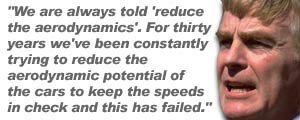 "If we release the tires then the speeds will go up and we know that the energy of the impact is directly proportional to the grip of the car and the tires are a very big part of the grip of the car. So [the tires] are something we can get hold of and do no matter what the engineers do. If we reduce the amount of rubber on the road the car will slow down. The principle is elementary.
"If we release the tires then the speeds will go up and we know that the energy of the impact is directly proportional to the grip of the car and the tires are a very big part of the grip of the car. So [the tires] are something we can get hold of and do no matter what the engineers do. If we reduce the amount of rubber on the road the car will slow down. The principle is elementary.
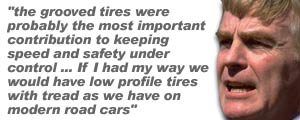 Another subject that came up was the delectable question of which team may have been cheating by means of electronic devices and programs last season to achieve a form of "traction control." Max declines to name the "Geek Cheats" who may have had illegal software in the 1999 season: he will not name the team (or even the color of the car!) until the FIA is 100% sure, a high, perhaps unattainable standard of proof.
Another subject that came up was the delectable question of which team may have been cheating by means of electronic devices and programs last season to achieve a form of "traction control." Max declines to name the "Geek Cheats" who may have had illegal software in the 1999 season: he will not name the team (or even the color of the car!) until the FIA is 100% sure, a high, perhaps unattainable standard of proof.
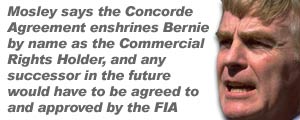 Speaking of Ecclestone, as one of the principal draftsman of the Concorde Agreement, Mosley has a surprise in store for all those people who think Bernie is on his way out based upon his recent sales of interests in his Formula One holdings and his age, now nearly 70 years old. Mosley says the Concorde Agreement enshrines Bernie by name as the Commercial Rights Holder, the person authorized by the FIA to exploit the commercial side of Formula One. Moreover, Mosley further provides that any successor to Bernie proposed by Mr. Haffa or anyone else in the future would have to be agreed to and approved by the FIA.
Speaking of Ecclestone, as one of the principal draftsman of the Concorde Agreement, Mosley has a surprise in store for all those people who think Bernie is on his way out based upon his recent sales of interests in his Formula One holdings and his age, now nearly 70 years old. Mosley says the Concorde Agreement enshrines Bernie by name as the Commercial Rights Holder, the person authorized by the FIA to exploit the commercial side of Formula One. Moreover, Mosley further provides that any successor to Bernie proposed by Mr. Haffa or anyone else in the future would have to be agreed to and approved by the FIA.
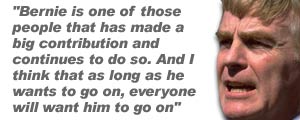 Turning to the subject of the United States Grand Prix, this season's newest race, like Bernie, Mosley has been to the site of the newest Formula One track - the Indianapolis Motor Speedway - a couple of times in fact , once for the 1992 Indianapolis 500, just after he was elected President of the FIA in 1991, and once for the inaugural Brickyard 400, a NASCAR event, in 1994. Although he has not personally inspected the new Formula open track built in the infield of the famous 2.5 mile oval track (that job went to the omnipresent Charlie Whiting, FIA's Safety and Technical Delegate), he got to know Indy well during his prior visits.
Turning to the subject of the United States Grand Prix, this season's newest race, like Bernie, Mosley has been to the site of the newest Formula One track - the Indianapolis Motor Speedway - a couple of times in fact , once for the 1992 Indianapolis 500, just after he was elected President of the FIA in 1991, and once for the inaugural Brickyard 400, a NASCAR event, in 1994. Although he has not personally inspected the new Formula open track built in the infield of the famous 2.5 mile oval track (that job went to the omnipresent Charlie Whiting, FIA's Safety and Technical Delegate), he got to know Indy well during his prior visits.
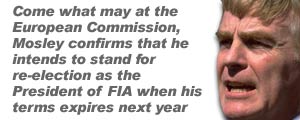 A year ago, at the official press conference he held at the British Grand Prix, Mosley said: "As I feel at the moment, if I last until October 2001 that will be it; I will think very carefully before standing for a third time because it is actually wrong for people to do these jobs for too long." But when asked, just as our meeting is about to end, if he is going to run again when his term ends, Mosley answers: "Probably."
A year ago, at the official press conference he held at the British Grand Prix, Mosley said: "As I feel at the moment, if I last until October 2001 that will be it; I will think very carefully before standing for a third time because it is actually wrong for people to do these jobs for too long." But when asked, just as our meeting is about to end, if he is going to run again when his term ends, Mosley answers: "Probably."